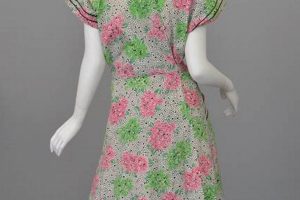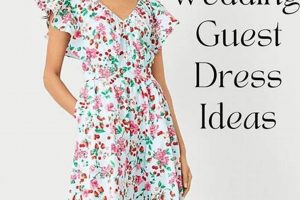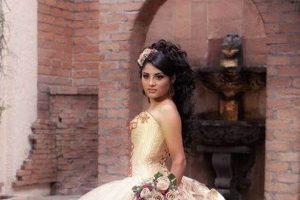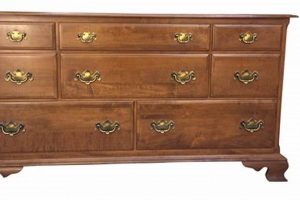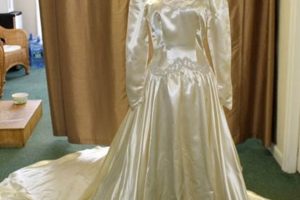Garments combining demure design elements with the charm of bygone eras present a unique bridal aesthetic. These gowns often feature higher necklines, longer sleeves, and fuller skirts, drawing inspiration from various historical periods while maintaining a sense of traditional propriety. For example, a lace-sleeved A-line dress reminiscent of the 1950s, crafted with satin and featuring minimal embellishments, exemplifies this bridal style.
Selecting such attire provides an opportunity to express individuality while adhering to personal values or religious customs. The enduring appeal of these classic designs lies in their timeless elegance and refined silhouettes. Furthermore, embracing pre-owned or vintage pieces promotes sustainability and offers a connection to the past, creating a garment with a unique history and character.
The following sections will delve into specific design elements, explore popular historical influences, and provide guidance on sourcing and styling options for those seeking this particular bridal aesthetic. Considerations for fabric selection, alteration possibilities, and complementary accessories will also be addressed to assist in creating a cohesive and personalized wedding day ensemble.
Guidance for Selecting a Classic and Understated Bridal Gown
The following recommendations offer insights into acquiring a bridal garment that embodies both modesty and vintage appeal. Attention to detail and a discerning approach are essential for achieving a desired aesthetic that reflects personal taste and values.
Tip 1: Research Historical Silhouettes: Familiarize oneself with dress shapes and details prevalent in different eras, such as the empire waistlines of the early 19th century or the tea-length skirts of the 1950s. This knowledge informs the selection process and ensures an authentic vintage-inspired look.
Tip 2: Prioritize Fabric Choice: Select materials that drape gracefully and maintain opacity. Consider classic options like satin, lace, chiffon, or crepe, opting for heavier weights to ensure adequate coverage and a refined appearance.
Tip 3: Examine Neckline and Sleeve Options: High necklines, such as bateau, jewel, or modest V-necks, are indicative of a modest design. Long sleeves, three-quarter sleeves, or cap sleeves provide additional coverage and complement the overall aesthetic.
Tip 4: Evaluate Dress Length and Fullness: Floor-length gowns or tea-length styles often align with modesty principles. A-line or full skirts provide a balanced silhouette that avoids excessive body-consciousness.
Tip 5: Scrutinize Embellishments: Opt for minimal and tasteful embellishments. Delicate lace appliques, subtle beading, or understated embroidery can enhance the dress without compromising its inherent simplicity.
Tip 6: Assess Condition and Alteration Potential: When considering vintage garments, carefully assess their condition. Factor in the cost of alterations to ensure a proper fit and address any necessary repairs or modifications to align with personal preferences.
Tip 7: Consider Undergarments: Select supportive and seamless undergarments that provide a smooth foundation and maintain the dress’s intended shape. Proper undergarments are crucial for achieving a polished and refined appearance.
Careful consideration of these elements will assist in the successful selection of a bridal gown that aligns with principles of modesty while embodying the timeless elegance of vintage design.
The subsequent sections will explore potential sources for locating such garments and offer guidance on styling the overall bridal look to complement the chosen dress.
1. Timeless Elegance
The allure of “modest vintage wedding dresses” is inextricably linked to the concept of timeless elegance. These gowns often eschew fleeting trends in favor of classic silhouettes and refined details that resonate across generations. The inherent modesty, characterized by features such as higher necklines and longer sleeves, contributes directly to this sense of enduring grace. This is because such design elements often prioritize sophistication over overt sensuality, resulting in a visual appeal that transcends the superficiality of contemporary fashion fads. The cause-and-effect relationship is clear: the inclusion of modest features, combined with vintage design, results in a heightened sense of timelessness.
The importance of timeless elegance as a core component of “modest vintage wedding dresses” cannot be overstated. It is the quality that ensures the gown remains relevant and beautiful for years to come, even decades after the wedding day. Consider, for instance, a 1930s-inspired gown with a bias-cut skirt, long lace sleeves, and a subtle train. The inherent sophistication of the design, coupled with its modest elements, ensures that the dress would look equally appropriate and beautiful today as it did nearly a century ago. The practical significance of understanding this connection lies in its ability to guide the selection process. By prioritizing designs that embody timeless elegance, brides can ensure that their chosen gown remains a cherished heirloom and a symbol of enduring style.
In summary, the harmonious blend of modesty and vintage design cultivates an aesthetic of timeless elegance, a crucial factor in the enduring appeal of these bridal gowns. While sourcing authentically vintage dresses may present challenges in terms of condition and fit, the resulting garment offers a unique combination of history, style, and personal values, contributing to a bridal look that is both beautiful and meaningful. The association with enduring grace provides access to an item of value.
2. Classic Silhouettes
The appeal of garments combining modesty and vintage design hinges significantly on the enduring attraction of specific silhouettes. These shapes, proven across decades, offer both visual appeal and the necessary coverage often associated with a demure aesthetic. Their prevalence in historical fashion contributes to the overall vintage sensibility, making them a cornerstone of this bridal style.
- The A-Line
Characterized by its fitted bodice and gradually widening skirt, the A-line silhouette offers a flattering and universally appealing shape. Its balanced proportions provide modesty without sacrificing style. In the context of garments marrying decency and nostalgia, the A-line evokes styles from the 1950s and 60s, eras known for their ladylike elegance. This silhouette allows for comfortable movement and can be adapted to various lengths, further enhancing its versatility.
- The Empire Waist
Featuring a high waistline just below the bust, the Empire waist creates a flowing and graceful appearance. This silhouette is particularly suited for those seeking a modest aesthetic, as it minimizes emphasis on the natural waist and hips. Reminiscent of Regency-era gowns, the Empire waist lends a romantic and historical touch to bridal attire. This design also provides comfort and freedom of movement, making it a practical choice for a wedding day.
- The Ballgown
With its fitted bodice and full, voluminous skirt, the ballgown silhouette exudes traditional bridal elegance. When incorporated into designs prioritizing coverage and vintage charm, the ballgown offers a regal and sophisticated option. This silhouette often features long sleeves, high necklines, and intricate embellishments, further enhancing its modest appeal. While grand in scale, a thoughtfully designed ballgown can maintain a sense of understated grace.
- The Tea Length
Falling between the knee and ankle, the tea-length silhouette offers a distinctive vintage flair. Popularized in the mid-20th century, this length provides a refreshing alternative to floor-length gowns. In the context of the keyword, tea-length dresses offer a playful yet sophisticated aesthetic, showcasing the shoes and ankles while maintaining a sense of modesty. This silhouette is particularly well-suited for daytime or outdoor weddings.
These classic silhouettes, when thoughtfully integrated with vintage design elements and a commitment to modest coverage, provide a range of options for brides seeking a bridal style that is both timeless and reflective of their personal values. The selection of a silhouette serves as a foundational step in creating a cohesive and elegant wedding day ensemble, influencing fabric choice, embellishment style, and overall aesthetic.
3. Coverage and Decency
The principles of coverage and decency are intrinsically linked to the selection and appreciation of wedding dresses that combine modesty with vintage design. In this context, coverage refers to the extent to which the garment conceals the body, while decency pertains to the overall aesthetic appropriateness of the attire within a specific cultural or religious framework. A direct causal relationship exists: the conscious prioritization of coverage and decency influences the design choices and ultimately shapes the final appearance of these gowns. Garments adhering to these principles often feature higher necklines, longer sleeves, and fuller skirts, minimizing exposure and promoting a sense of traditional decorum. The cause (emphasis on coverage and decency) directly affects the effect (the specific design elements and overall aesthetic of the dress).
The significance of coverage and decency as components of these garments stems from a variety of motivations, including religious beliefs, personal values, and cultural expectations. For some, adhering to these principles is a matter of faith, reflecting a commitment to specific religious doctrines regarding appropriate attire. For others, it represents a personal preference for a more understated and refined aesthetic, prioritizing elegance and sophistication over overt displays of sensuality. Instances of garments reflecting these principles are found in vintage patterns and designs across various eras, from the high-necked, long-sleeved gowns of the Victorian era to the demure tea-length dresses of the 1950s. The practical significance of understanding this connection lies in its ability to inform the selection process. Brides consciously seeking garments embodying coverage and decency can more effectively identify designs that align with their values and create a bridal look that is both beautiful and meaningful.
In conclusion, the concepts of coverage and decency are essential considerations in the realm of wedding dresses combining modesty and vintage design. These principles serve as guiding factors in the selection and appreciation of such attire, influencing design choices and reflecting personal values. While challenges may arise in sourcing authentically vintage dresses that perfectly align with individual preferences, the resulting garment offers a unique combination of history, style, and personal expression, contributing to a bridal ensemble that is both elegant and ethically sound. A balanced perspective on garment preservation and decency, ensures the choice reflects enduring grace.
4. Era-Specific Designs
The incorporation of distinct historical periods profoundly influences the aesthetic and construction of garments that prioritize both modesty and vintage design. These designs borrow recognizable elements from specific eras, creating a tangible link to the past and allowing for a diverse range of stylistic expressions.
- Victorian Era (1837-1901)
Gowns from this period often feature high necklines, long sleeves (typically with lace or other delicate embellishments), and full, floor-length skirts. The emphasis on modesty was paramount, reflecting the social norms of the time. Fabrics such as silk, satin, and lace were common, often layered to create texture and depth. The silhouette typically involved a fitted bodice and a gradually widening skirt, sometimes supported by a crinoline. The influence of the Victorian era can be seen in the continued preference for high necklines and lace detailing in wedding attire adhering to modesty standards.
- Edwardian Era (1901-1910)
While maintaining a sense of modesty, the Edwardian era saw a slight softening of silhouettes compared to the Victorian period. Gowns often featured flowing lines, delicate lace overlays, and intricate embroidery. The S-bend corset created a distinctive shape, pushing the bust forward and creating a curved silhouette. Necklines remained relatively high, but the use of lighter fabrics such as chiffon and tulle gave the gowns a more ethereal quality. Details such as Carrickmacross lace and handmade flowers were frequently incorporated. The influence of the Edwardian era is evident in the use of delicate fabrics and intricate detailing in current vintage-inspired designs.
- 1930s Hollywood Glamour
This era brought a touch of sophistication and elegance to bridal wear. Dresses often featured bias-cut silhouettes that draped beautifully and accentuated the figure without being overtly revealing. While not always inherently modest, the designs could be adapted to incorporate longer sleeves or higher necklines while maintaining the overall glamorous aesthetic. Fabrics such as silk crepe and satin were favored, often adorned with subtle embellishments such as beading or sequins. The influence of 1930s Hollywood glamour can be seen in the enduring popularity of bias-cut gowns and elegant, understated embellishments.
- 1950s Tea-Length Dresses
This decade saw the rise of the tea-length dress, a playful yet elegant alternative to floor-length gowns. Characterized by a fitted bodice and a full, calf-length skirt, these dresses often featured details such as sweetheart necklines, cap sleeves, and circle skirts. While some designs could be quite revealing, many 1950s dresses offered modest coverage with the addition of higher necklines or longer sleeves. Fabrics such as cotton, tulle, and lace were popular choices. The influence of 1950s tea-length dresses can be seen in the continued popularity of this silhouette for vintage-inspired bridal wear, offering a refreshing and practical option for modern brides seeking both style and modesty.
The selection of specific era-inspired details allows for a diverse range of interpretations within the framework of garments prioritizing coverage and vintage charm. Understanding the characteristics of these periods provides a foundation for creating a bridal look that is both historically informed and personally meaningful.
5. Fabric Opacity
Fabric opacity, the degree to which a material prevents light from passing through, is a critical factor in the construction and selection of garments combining modesty and vintage design. A direct correlation exists: higher fabric opacity contributes directly to the perceived and actual modesty of a dress. The use of translucent or sheer materials would inherently compromise the desired aesthetic of understated elegance and demure coverage. Therefore, fabrics with substantial opacity are essential for ensuring that the design adheres to principles of decorum. An example of this is a vintage satin gown with a lining of similar weight; this construction effectively prevents transparency and maintains a dignified appearance. In contrast, a similar gown made from unlined lace would fail to provide adequate coverage, regardless of its vintage charm.
The importance of fabric opacity is amplified by the styles and silhouettes often associated with vintage designs. Many historical periods favored layering and heavier fabrics, both contributing to increased opacity. The selection of appropriate fabrics ensures that vintage-inspired designs maintain the visual integrity of the original era while adhering to standards of modesty. Furthermore, the use of lining, underlining, or other supportive layers can enhance fabric opacity and provide structure to the garment. For instance, a chiffon overlay, a fabric often used in vintage designs, would typically be paired with an opaque lining to ensure adequate coverage. This approach allows designers to incorporate delicate and ethereal fabrics without sacrificing modesty. Ignoring the selection of dense textiles leads to garments that do not properly translate its intended aesthetic.
In summary, fabric opacity constitutes a fundamental element in the successful creation and appreciation of garments that combine modesty and vintage design. The careful selection of opaque materials, often reinforced through layering or lining, ensures that the garment provides adequate coverage and maintains a refined aesthetic. While finding authentically vintage dresses with perfectly opaque fabrics may present challenges, the application of modern techniques such as adding linings or interfacings can address these issues, allowing for the creation of a bridal ensemble that is both historically informed and aligned with personal values. Prioritization of fabric opacity ensures that a gown is appropriate, elegant, and maintains its vintage charm.
6. Subtle Embellishments
The incorporation of understated decorative elements plays a critical role in enhancing the aesthetic appeal of modest vintage wedding dresses. These embellishments, rather than dominating the design, serve to accentuate the garment’s inherent elegance and historical charm, contributing to a refined and sophisticated bridal look.
- Lace Appliqus
Delicate lace appliqus, strategically placed on the bodice, sleeves, or skirt of the gown, add a touch of romanticism and texture without compromising modesty. These appliqus, often crafted from fine materials such as Chantilly or Alenon lace, offer a subtle visual interest that complements the overall design. An example includes scattering floral lace motifs along the sleeves of a high-necked Edwardian-inspired gown, enhancing its vintage charm while maintaining a demure silhouette.
- Beaded Accents
Subtle beading, such as seed pearls or delicate crystals, can be incorporated to provide a hint of shimmer and sophistication. These embellishments are typically used sparingly, often adorning necklines, cuffs, or waistbands. A 1930s-inspired gown, featuring a bias-cut silhouette and long sleeves, might incorporate subtle beading along the neckline, adding a touch of Hollywood glamour without being overtly flashy.
- Embroidery Details
Understated embroidery, executed in thread colors that complement the fabric of the gown, offers a subtle and elegant form of embellishment. Floral motifs, geometric patterns, or delicate scrollwork can be embroidered onto the bodice, skirt, or sleeves, adding texture and visual interest. A Victorian-inspired gown might feature embroidered flowers along the hem of the skirt, providing a subtle yet sophisticated decorative element.
- Covered Buttons
The use of covered buttons, often made from the same fabric as the gown, provides a refined and understated form of embellishment. These buttons can be used to close the back of the gown, adorn the cuffs of long sleeves, or add a decorative touch to the bodice. A 1950s-inspired tea-length dress might feature a row of covered buttons down the back, adding a touch of vintage charm and sophistication.
These subtle embellishments, when thoughtfully integrated into the design, enhance the overall aesthetic of modest vintage wedding dresses. They contribute to a refined and sophisticated bridal look, emphasizing the garment’s inherent elegance and historical charm without compromising its demure silhouette.
7. Preservation Condition
The preservation condition of a vintage wedding dress is intrinsically linked to its suitability as a modest garment. Garments exhibiting significant damage, discoloration, or structural weaknesses often necessitate alterations or repairs that can compromise the original design and, consequently, its modesty. The cause-and-effect relationship is apparent: deterioration of the fabric or embellishments may lead to the need for modifications that result in a lower neckline, shorter sleeves, or a less voluminous skirt, thus undermining the initial intent of a demure aesthetic. For instance, a tear in the lace of a sleeve may require its removal, altering the intended coverage and overall silhouette. Conversely, a well-preserved gown requires minimal intervention, maintaining its original design integrity and modesty.
The importance of preservation condition cannot be overstated when considering a vintage gown for its modesty. Stains, yellowing, or weakened fibers can necessitate treatments that may be harsh or ineffective, potentially damaging the fabric further or requiring the replacement of entire sections. If the replacement fabric is not an exact match, the aesthetic cohesion of the garment is compromised, and achieving the desired level of modesty becomes more challenging. Consider a 1920s gown with extensive beadwork; if the beadwork is damaged and requires replacement, sourcing identical beads can be difficult, potentially leading to an inconsistent and less demure appearance. Evaluating the gown’s condition before purchase allows for a realistic assessment of the alterations required to restore its structural integrity and preserve its modest design elements.
In summary, the preservation condition of a vintage wedding dress directly impacts its viability as a modest garment. Significant damage necessitates alterations that may compromise the original design’s modesty, while a well-preserved gown requires minimal intervention. The challenge lies in carefully assessing the garment’s condition and realistically evaluating the potential alterations required to restore its structural integrity while maintaining its demure aesthetic. This assessment is crucial for ensuring the selected gown aligns with both vintage charm and personal values of modesty.
Frequently Asked Questions
The following addresses common inquiries and misconceptions regarding the selection, sourcing, and styling of bridal attire that balances both a demure aesthetic and elements of historical fashion.
Question 1: What design elements are typically associated with garments that prioritize modesty?
These garments often incorporate higher necklines, such as bateau, jewel, or modest V-necks. Longer sleeves, ranging from cap sleeves to full-length options, are also common. Skirts tend to be fuller and longer, typically reaching floor-length or tea-length, avoiding revealing silhouettes.
Question 2: Which historical eras offer styles readily adaptable to a modest bridal aesthetic?
The Victorian and Edwardian eras provide numerous examples of gowns with high necklines, long sleeves, and full skirts. The 1930s offer elegant, bias-cut designs that can be modified to increase coverage. The 1950s tea-length dresses present a playful yet sophisticated option for a demure bridal look.
Question 3: How does fabric choice impact the perceived modesty of a garment?
Opaque fabrics are essential for ensuring adequate coverage. Materials such as satin, crepe, and heavier lace provide greater opacity than sheer fabrics like chiffon or tulle. Linings and underlays can be used to increase the opacity of lighter fabrics.
Question 4: What are the key considerations when sourcing an authentically vintage bridal gown?
Assess the garment’s condition carefully, paying attention to stains, tears, and structural weaknesses. Factor in the cost of alterations and repairs. Verify the fabric’s integrity and its suitability for cleaning and restoration. Ensure the size and silhouette align with the desired modest aesthetic.
Question 5: How can contemporary designs incorporate elements of both modesty and historical fashion?
Designers can draw inspiration from vintage silhouettes, fabrics, and embellishments while adapting them to modern sensibilities. This may involve incorporating higher necklines and longer sleeves into contemporary dress designs or utilizing vintage lace and embroidery techniques on modern fabrics.
Question 6: Are alterations always necessary when selecting a vintage garment?
Alterations are often required to achieve a proper fit and ensure the garment aligns with the desired modest aesthetic. Hem adjustments, sleeve modifications, and neckline alterations may be necessary to customize the gown to individual preferences and body type.
Consideration of these factors enables a more informed approach to the selection and styling of bridal attire that reflects both a commitment to modesty and an appreciation for historical fashion.
The following section will provide guidance on styling the selected bridal garment to create a cohesive and elegant wedding day ensemble.
Conclusion
The preceding exploration has elucidated the multifaceted nature of garments combining demure design with the charm of bygone eras. Key aspects, including timeless elegance, classic silhouettes, fabric opacity, and the condition of preservation, have been examined to provide a comprehensive understanding. The analysis highlights the importance of informed decision-making when selecting or creating such attire, emphasizing the need to balance historical accuracy with personal values.
The enduring appeal of these garments lies in their ability to represent a unique blend of tradition, individuality, and ethical considerations. As bridal fashion continues to evolve, the principles outlined herein offer a valuable framework for those seeking attire that is both beautiful and meaningful. Further research and thoughtful consideration are encouraged to ensure the selected ensemble resonates with personal beliefs and creates a lasting impression.


